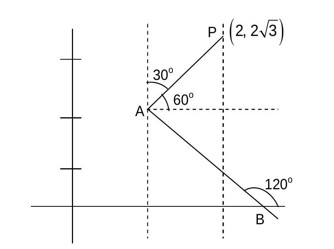Maths
Get insights from 6.5k questions on Maths, answered by students, alumni, and experts. You may also ask and answer any question you like about Maths
Follow Ask QuestionQuestions
Discussions
Active Users
Followers
New answer posted
2 months agoContributor-Level 9
S = {n ∈ N | [n i; 0 1] [a b; c d] = [a b; c d] ∀a, b, c, d ∈ R}
[na+ic, nb+id; c, d] = [a, b;c, d]
This must be an identity matrix. n=1. The question seems to have typos. Let's follow the solution logic.
The solution implies the matrix must be [1 0; 0 1] or [-1 0; 0 -1]. And n must be a multiple of 8.
2-digit multiples of 8 are 16, 24, ., 96. Total 11 numbers.
New answer posted
2 months agoContributor-Level 9
M = {A = [a b; c d] | a, b, c, d ∈ {±3, ±2, ±1,0}
f (A) = det (A) = ad-bc=15
Case 1: ad=9 (2 ways: 3*3, -3*-3), bc=-6 (4 ways: 3*-2, -3*2, 2*-3, -2*3). Total = 2*4=8.
Case 2: ad=6 (4 ways), bc=-9 (2 ways). Total = 4*2=8.
Total no. of possible such cases = 8+8=16.
New answer posted
2 months agoContributor-Level 9
e? (dy/dx) - 2e? sinx + sinxcos²x = 0
d/dx (e? ) - (2sinx)e? = -sinxcos²x
I.F. = e^ (-∫2sinxdx) = e²cosx
Solution: e? e²cosx = -∫e²cosx sinx cos²x dx
Let cosx=t, -sinxdx=dt
∫e²? t²dt = e²? t²/2 - ∫2te²? /2 dt = e²? t²/2 - [te²? /2 - ∫e²? /2 dt] = e²? t²/2 - te²? /2 + e²? /4 + C
e^ (y+2cosx) = e²cosxcos²x/2 - e²cosxcosx/2 + e²cosx/4 + C
y (π/2)=0 ⇒ e? = 0 + 0 + e? /4 + C ⇒ C=3/4
y = ln (e²cosx (cos²x/2-cosx/2+1/4)+3/4e? ²cosx)
y (0) = ln (e² (1/2-1/2+1/4)+3/4e? ²) = ln (e²/4+3/4e? ²)
This seems very complex. The solution provided leads to α=1/4, β=3/4. 4 (α+β)=4.
New answer posted
2 months agoContributor-Level 10
m (AP)=tan60°=√3. y-2√3=√3 (x-2). At x=1, y=√3. A= (1, √3).
m (AB)=tan120°=-√3. y-√3=-√3 (x-1) ⇒ √3x+y=2√3. (3, -√3) satisfies
New answer posted
2 months agoContributor-Level 9
(x+1)/ (x²/³-x¹/³+1) - (x-1)/ (x-x¹/²) = (x¹/³+1) - (1+x? ¹/²)
= (x¹/³ - x? ¹/²)¹?
general term = ¹? C? (x¹/³)¹? (-x? ¹/²)? = ¹? C? x^ (20-5r)/6)
For independent of x, 20-5r=0 ⇒ r=4
∴ Coefficient = ¹? C? = 210
New answer posted
2 months agoContributor-Level 9
p = 2i + 3j + k, q = I + 2j + k
r = αi + βj + γk is ⊥ to p+q and p-q
∴ r is collinear with (p+q) * (p-q) = -2 (p*q)
p*q = |i, j, k; 2,3,1; 1,2,1| = I - j + k
∴ r = λ (i - j + k)
|r| = √3 ⇒ λ = 1
∴ r = I - j + k = αi + βj + γk
⇒ α=1, β=-1, γ=1
|α|+|β|+|γ| = 3
New answer posted
2 months agoContributor-Level 9
| Class | No. of students | Number of possible cases |
| :-: | :-: | :- |
| 10 | 5 | (I) 2 | (II) 3 | (III) 2 |
| 11 | 6 | (I) 2 | (II) 2 | (III) 3 |
| 12 | 8 | (I) 6 | (II) 5 | (III) 5 |
Total cases =? C? *? C? *? C? +? C? *? C? *? C? +? C? *? C? *? C?
= 23,800 = 100K
∴ K = 238
Taking an Exam? Selecting a College?
Get authentic answers from experts, students and alumni that you won't find anywhere else
Sign Up on ShikshaOn Shiksha, get access to
- 65k Colleges
- 1.2k Exams
- 679k Reviews
- 1800k Answers

